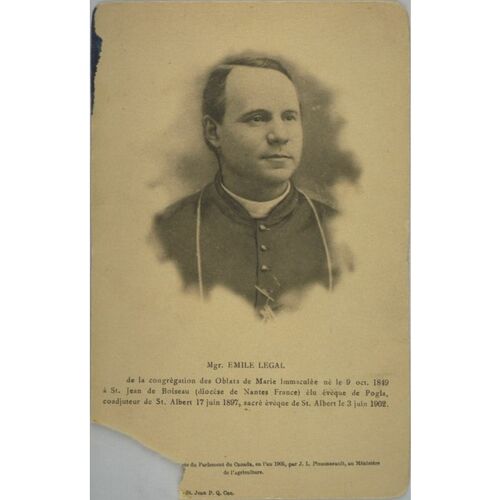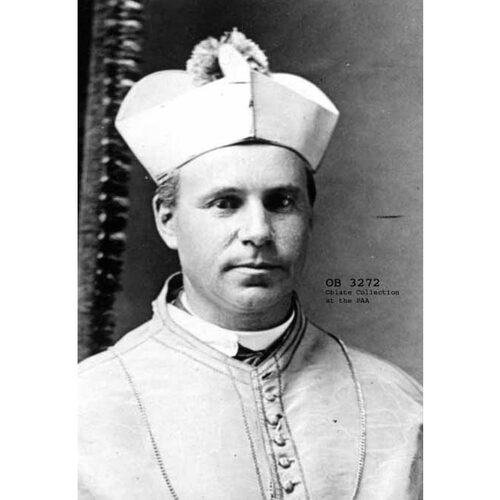![Mgr. Émile Legal, OMI, [1897-1920]. (OB3272 - Oblate Collection at the PAA) Original title: Mgr. Émile Legal, OMI, [1897-1920]. (OB3272 - Oblate Collection at the PAA)](/bioimages/w600.3692.jpg)
Source: Link
LEGAL, ÉMILE-JOSEPH, Roman Catholic priest, Oblate of Mary Immaculate, and bishop; b. 9 Oct. 1849 in Saint-Jean-de-Boiseau, France, son of Julien Legal and Perrine David, millers; d. 10 March 1920 in Edmonton.
Émile-J. Legal studied at the petit and grand séminaires in Nantes, the Collège de Machecoul, and the Université de France. He was ordained on 29 June 1874 and served in the diocese of Nantes prior to entering the Oblate noviciate in Nancy in 1879. As a result of restrictive state legislation governing religious orders, he was sent to Lachine, Que., where he completed his probationary year and made his perpetual vows on 24 Sept. 1880. Before being posted to the Canadian northwest, he served in Plattsburgh, N.Y., Montreal, and Buffalo, N.Y., where he studied English.
Legal arrived in St Albert (Alta) in August 1881 and was sent to minister to the Peigan in October. He spent the winter of 1881–82 on the Peigan Indian Reserve and visited other Blackfoot camps in the summer months in addition to ministering to the needs of Catholics in nearby Fort Macleod. In 1886 Legal opened a small school on the Peigan reserve and, two years later, he organized missions among the Blood. In 1889 he founded Saint-François-Xavier mission at Stand Off on the Blood Indian Reserve. He succeeded in having the Department of Indian Affairs build a hospital there in 1893 and confided its administration to the Grey Nuns of Nicolet, Que.
In the mid 1890s the health of Bishop Vital-Justin Grandin* of St Albert was causing concern among the clergy of the diocese, who believed that the appointment of a coadjutor was crucial. Legal’s candidacy had been suggested earlier by Father Albert Lacombe. On 29 March 1897 Legal was named titular bishop of Pogla and coadjutor of St Albert. He received the news of his nomination on 6 May, shortly after having personally buried a young resident of the Blood reserve, and thus the influential La Croix (Paris) referred to him as “the grave-digger bishop.” He was consecrated in St Albert on 17 June 1897 and chose as his episcopal motto Nos autem in nomine Domini (“As for us, we speak in the name of the Lord”). The Blackfoot named him Sspomitapi, meaning “he who sits on high.” Upon the death of Grandin on 3 June 1902, Legal became bishop of St Albert; he was made archbishop of Edmonton on 30 Nov. 1912.
As both missionary and prelate, Legal demonstrated remarkable intellectual and creative talents. He designed and constructed many buildings while serving in the Blood and Peigan missions. As bishop, he drew plans for numerous churches and carefully scrutinized those that were submitted by parish priests. He designed residential schools at Brocket, Stand Off, Blackfoot Crossing, and Saint-Paul-des-Métis (St Paul). He also marked out construction sites, purchased materials, and obtained the necessary authorizations to build. His plans for the cathedral in St Albert combined Gothic, neo-Roman, neo-Baroque, and Moorish styles. Construction began in 1902 but Legal had to modify his design to reduce costs in view of local economic conditions. With the creation of the archdiocese of Edmonton in 1912 and the subsequent transfer of the episcopal seat to that city in 1917, a cathedral in St Albert was no longer necessary and Legal turned his attention to constructing one in Edmonton.
Legal’s creative activities found expression as well in numerous studies of the traditions and customs of the Blackfoot and their language, including articles published in Les Missions catholiques (Lyon), the Catholic encyclopedia (New York), and the Bulletin of the Société de Géographie de Paris. He also collaborated with Lacombe in the preparation of a Blackfoot, Blood, and Peigan vocabulary. In addition, he undertook geological studies and corresponded with the Smithsonian Institution. He was awarded an lld honoris causa by the University of Alberta in 1915.
Upon being named coadjutor in 1897, Legal had assumed responsibility for the expansion of the diocese of St Albert, especially the creation of new parishes and institutions to serve a rapidly growing immigrant population. These activities he later recalled in Short sketches of the history of the Catholic churches and missions in central Alberta. As bishop, Legal also concerned himself with the status of Catholic schools in his diocese and he communicated with federal and territorial officials. In 1904, prior to the creation of the provinces of Alberta and Saskatchewan, he was asked by the apostolic delegate, Donato Sbarretti y Tazza, to prepare a draft clause for the Autonomy Bills safeguarding the principle of denominational schools in the new jurisdictions. Legal felt that the compromise clause negotiated between the apostolic delegate and Prime Minister Sir Wilfrid Laurier was inadequate: although it conferred separate-school privileges on the religious minority in any district, it did not define precisely the school system that was to be established. Nevertheless, since the apostolic delegate approved of it, Legal believed that it had to be upheld. In February 1905 Legal was interviewed for the newspaper United Canada (Ottawa). He expressed his hope that separate schools would be maintained and that Catholics would take action to support them. The published version, however, indicated that Legal was satisfied with the educational clause of the bills, and this allegation outraged other members of the hierarchy such as Archbishop Adélard Langevin of St Boniface. Undoubtedly the bishops did not appreciate Legal giving an interview to a non-Catholic paper on such a delicate issue. They were, moreover, anxious to present a united front.
In the last years of Legal’s life his fellow French-speaking prelates were concerned over his succession. With the appointment of an English-speaking bishop, John Thomas McNally*, in Calgary in 1913 and the creation of the archdiocese of Winnipeg out of the archdiocese of St Boniface in 1915, ethnic rivalries had become a matter of fact in western episcopal nominations. Despite his declining health – he was a diabetic – Legal had not secured the appointment of a coadjutor and, in 1920, there were fears that Rome rather than the bishop himself would choose a successor or that it would appoint an English-speaking auxiliary. Legal died on 10 March 1920 and both French- and English-speaking factions of the hierarchy made representations to Rome on behalf of appropriate candidates. The appointment of Henry Joseph O’Leary* as archbishop of Edmonton in September seriously undermined the domination of the French element in the western sees.
Legal’s compilation of Short sketches of the history of the Catholic churches and missions in central Alberta was published in Winnipeg around 1914. Archival material concerning the subject is found in the collections of the Arch. Deschâtelets, Oblats de Marie-Immaculée (Ottawa), the Arch. Générales des Oblats de Marie-Immaculée (Rome), the Arch. des Oblats de Marie-Immaculée (Montreal), the Arch. de la Prov. Grandin (St Albert, Alta), and the Arch. of the Oblates of Mary Immaculate, Prov. of Alberta-Saskatchewan, held at the PAA.
Gilles Cadrin, “Émile Legal: de l’architecture des missions à l’architecture monumentale,” in Western Oblate Studies 2: proceedings of the second symposium on the history of the Oblates in western and northern Canada . . . , ed. R. [-J.-A.] Huel with Guy Lacombe (Lewiston, N.Y., 1992), 237–19. Gaston Carrière, Dictionnaire biographique des oblats de Marie-lmmaculée au Canada (4v., Ottawa, 1976-89). R.[-J.-A.] Huel, “The Irish French conflict in Catholic episcopal nominations: the western sees and the struggle for domination within the church,” CCHA, Study sessions, 42 (1975): 51–70.
Cite This Article
Raymond Huel, “LEGAL, ÉMILE-JOSEPH,” in Dictionary of Canadian Biography, vol. 14, University of Toronto/Université Laval, 2003–, accessed January 18, 2026, https://www.biographi.ca/en/bio/legal_emile_joseph_14E.html.
The citation above shows the format for footnotes and endnotes according to the Chicago manual of style (16th edition). Information to be used in other citation formats:
| Permalink: | https://www.biographi.ca/en/bio/legal_emile_joseph_14E.html |
| Author of Article: | Raymond Huel |
| Title of Article: | LEGAL, ÉMILE-JOSEPH |
| Publication Name: | Dictionary of Canadian Biography, vol. 14 |
| Publisher: | University of Toronto/Université Laval |
| Year of publication: | 1998 |
| Year of revision: | 1998 |
| Access Date: | January 18, 2026 |




